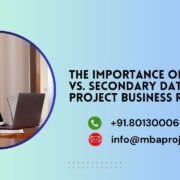The Importance of Primary vs. Secondary Data in MBA project business Research
The Importance of Primary vs. Secondary Data in MBA Project Business Research
The Importance of Primary vs. Secondary Data in MBA project business Research. When conducting business research for an MBA project, data collection plays a critical role in shaping the quality and reliability of your findings. The choice between primary and secondary data directly impacts the research’s validity, depth, and applicability to real-world business problems. Understanding the differences, advantages, and limitations of both data types is essential for making informed decisions in academic and professional research.
Understanding Primary and Secondary Data
What is Primary Data?
Primary data refers to information collected firsthand by the researcher specifically for the study. It is original, fresh, and tailored to meet the research objectives.
Examples of Primary Data in Business Research
- Surveys & Questionnaires – Gathering opinions from customers, employees, or stakeholders.
- Interviews – One-on-one discussions with industry experts, managers, or consumers.
- Focus Groups – Group discussions for insights into consumer behavior or market trends.
- Observations – Studying business processes, customer interactions, or employee performance.
- Experiments & Case Studies – Testing business strategies or analyzing real-life scenarios.
What is Secondary Data?
Secondary data consists of information that has already been collected and published by others. It is typically sourced from government reports, academic journals, industry publications, and company records.
Examples of Secondary Data in Business Research
- Company Reports & Financial Statements – Annual reports, balance sheets, and profit-loss statements.
- Market Research Reports – Industry trends, customer demographics, and competitor analysis.
- Government Databases – Economic indicators, trade statistics, and employment reports.
- Academic Journals & Books – Published research, case studies, and business theories.
- Online Databases & News Articles – Business insights from sources like Statista, Bloomberg, or Harvard Business Review.
Key Differences Between Primary and Secondary Data
| Aspect | Primary Data | Secondary Data |
|---|---|---|
| Source | Collected firsthand by the researcher | Previously gathered by other entities |
| Purpose | Designed to meet specific research needs | Originally collected for different purposes |
| Cost | Expensive (requires surveys, interviews, etc.) | Cost-effective or free |
| Time Consumption | Time-intensive | Readily available |
| Reliability | Highly accurate but requires careful execution | May be outdated or biased |
| Customization | Can be tailored to research needs | Limited flexibility |
Importance of Primary Data in MBA Business Research
1. Accuracy and Relevance
Primary data ensures that the information collected is specific, current, and directly related to the research problem. Unlike secondary data, which may be outdated or irrelevant, primary data provides fresh insights that can improve decision-making.
2. Competitive Advantage
For businesses, original research can uncover unique customer preferences, market trends, and operational inefficiencies that competitors may not have access to. MBA students conducting research for companies can use primary data to create innovative business strategies.
3. Addressing Specific Research Needs
MBA dissertations often focus on niche areas such as customer satisfaction, employee motivation, or digital transformation. Primary data allows researchers to tailor their methodologies to answer precise research questions.
4. Control Over Data Collection Methods
Researchers can design surveys, choose participants, and analyze data based on their study requirements. This control ensures that the research meets ethical and methodological standards.
Challenges of Using Primary Data
- Time-consuming and expensive – Conducting surveys or interviews requires significant effort.
- Potential bias – Poor questionnaire design or sampling errors can impact results.
- Limited scope – Small sample sizes may not represent broader industry trends.
Importance of Secondary Data in MBA Business Research
1. Quick and Cost-Effective
Secondary data is readily available and often free or low-cost. Researchers can access vast amounts of business information without investing time and money in data collection.
2. Historical and Comparative Analysis
Since secondary data includes past records and reports, researchers can analyze business trends, compare industry performances over time, and forecast future developments.
3. Establishing Theoretical Foundations
MBA research requires a solid literature review. Secondary data from books, journals, and case studies helps establish theoretical frameworks and business models that support primary research.
4. Validation and Benchmarking
Comparing primary data findings with secondary data allows researchers to validate their results. If primary research contradicts secondary sources, it may indicate new trends or potential gaps in existing knowledge.
Challenges of Using Secondary Data
- May be outdated or irrelevant – Business conditions change rapidly.
- Lack of control – Researchers cannot influence data collection methods.
- Potential bias – Reports from companies or interest groups may present skewed perspectives.
When to Use Primary vs. Secondary Data?
| Research Need | Best Data Type |
|---|---|
| Understanding customer preferences | Primary Data (Surveys, Interviews) |
| Studying past business performance | Secondary Data (Company Reports, Financial Statements) |
| Analyzing industry trends | Secondary Data (Market Research Reports, Government Data) |
| Testing a new product or strategy | Primary Data (Focus Groups, Experiments) |
| Supporting theoretical frameworks | Secondary Data (Academic Journals, Books) |
| Exploring workplace culture and leadership styles | Primary Data (Interviews, Observations) |
Combining Primary and Secondary Data for Optimal Research
For MBA research, the best approach is often a combination of primary and secondary data.
Example: A Study on Consumer Preferences for Sustainable Products
- Use Secondary Data to analyze industry reports on green consumer behavior.
- Conduct Primary Research through surveys to gather firsthand opinions on sustainable products.
- Compare and Validate findings from both data sources to draw accurate conclusions.
Conclusion
Both primary and secondary data play essential roles in MBA project business research. While primary data offers accuracy, specificity, and competitive advantage, secondary data provides historical insights, theoretical support, and cost-effective research opportunities. An effective MBA dissertation will strategically leverage both data types to enhance credibility, depth, and impact.
Would you like expert guidance on collecting and analyzing data for your MBA research? Let us know how we can help!








